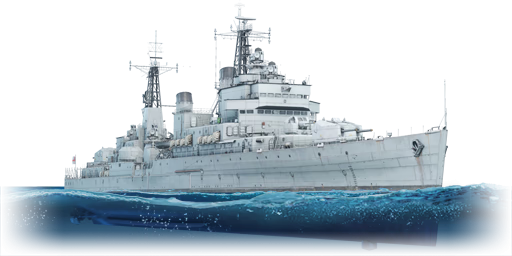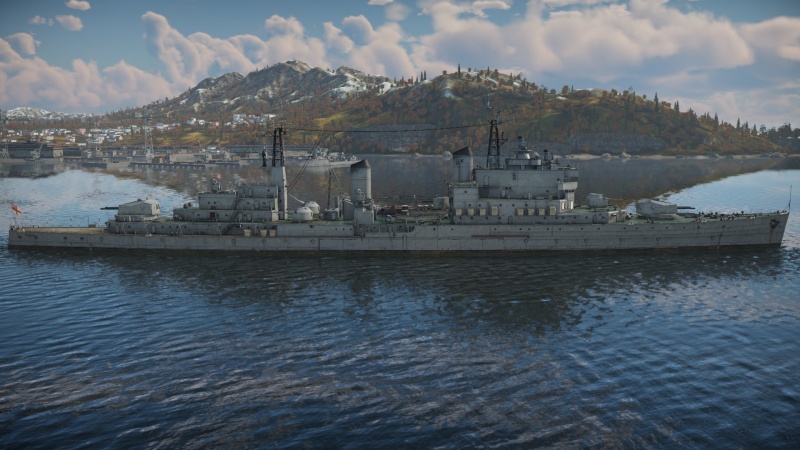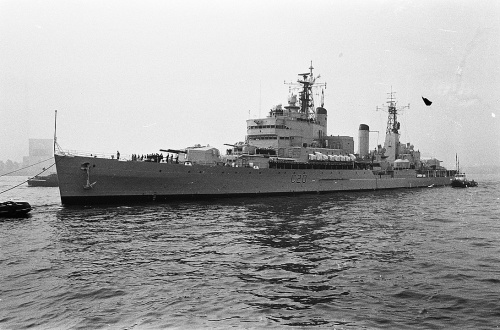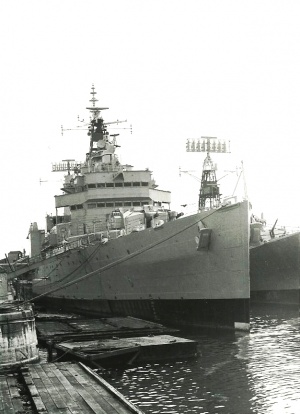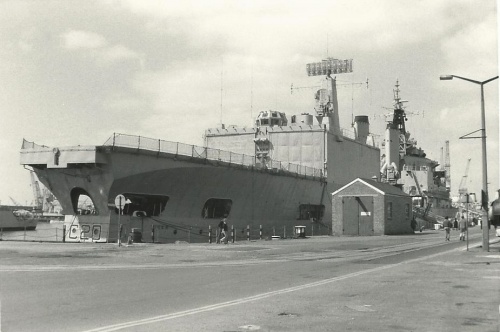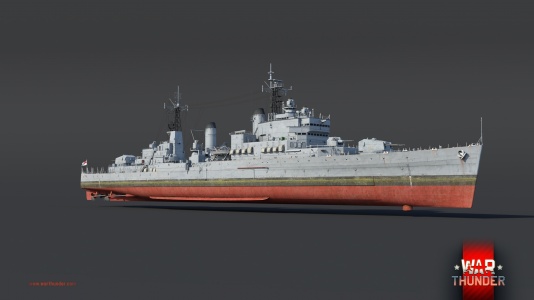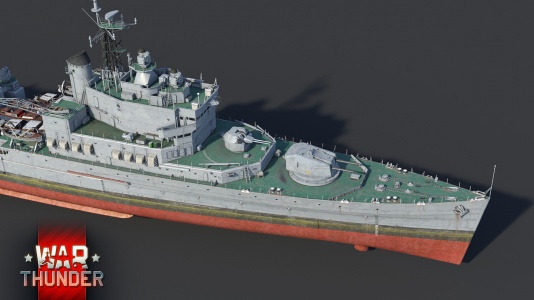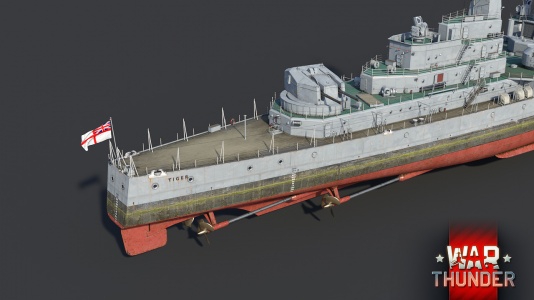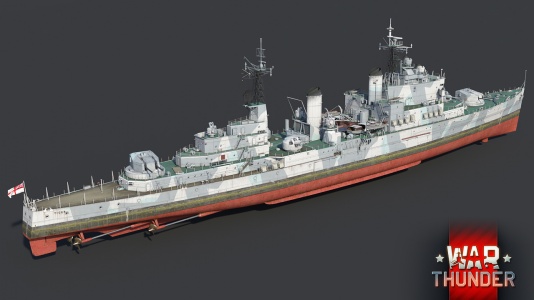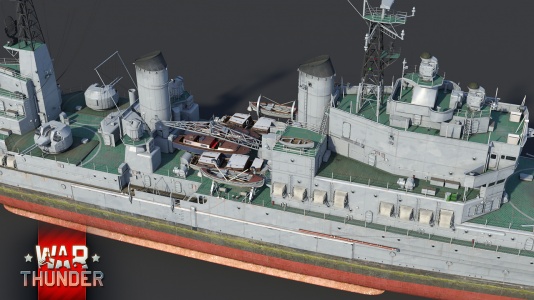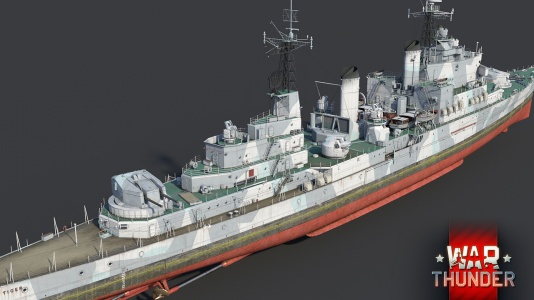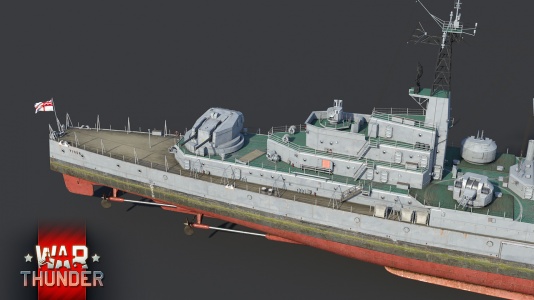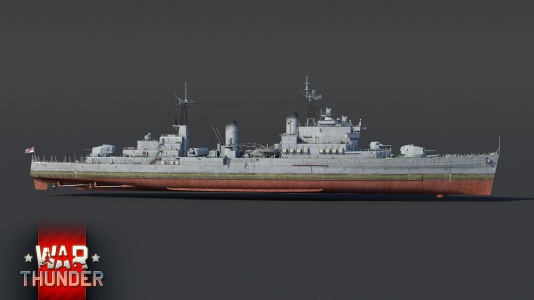HMS Tiger
Contents
Description
The Tiger-class, HMS Tiger (C20), 1960 is a gift rank V British light cruiser with a battle rating of 5.7 (AB/RB/SB). It was introduced in Update 1.87 "Locked On" as a reward for the "Battlefield Engineer" event.
General info
Survivability and armour
Armour
Overall, HMS Tiger has adequate, but not impenetrable, protection with large areas vulnerable in a close-range engagement. The armour on HMS Tiger follows an all-or-nothing scheme with only the critical areas of the ship protected. The belt consists of a main 89 mm RHA section that extends across most of the ship's length, protecting just above and just below the waterline. There is also the second section of 51 mm RHA that extends above the main belt to provide additional protection to the engine compartment. The main guns are lightly armoured, ranging from 55 mm RHA on the front turret face to 20 mm RHA on the turret sides. The strongest armour on HMS Tiger is the 50 mm RHA deck armour that covers the entire length of the ship. Unlike the majority of its tech tree equivalents, this armour is situated on the weather deck, effectively protecting not just the engines rooms but all systems below the bridge and turrets. This provides effective protection against plunging fire from all guns smaller than cruiser calibre.
The main battery magazines are poorly protected with only half of each covered by the main belt. Additionally, they are situated entirely above the waterline, making them highly vulnerable to detonations. These magazines are also massive, each taking up an entire turrets worth of space within the ship. Compared to the main magazines, the secondary magazines are significantly smaller and more protected, situated entirely behind the main armour belt.
The bridge and radio room sit exposed in the superstructure opposed to below deck or within an armoured conning tower. This makes them extremely vulnerable to any form of gunfire, not just cruiser calibre shells.
Survivability
Survivability on the HMS Tiger is lower than a lot of cruisers of the same size. This can be attributed to her overall low number of guns combined with her exposed main battery magazines. As the main armament consists of only two turrets, a couple of shells from a high calibre gun can entirely knock out her main guns, removing her ability to retaliate. The secondary guns don't fare much better as they are also low in number and easy to damage. The biggest boon to her survivability is her crew count of 880, meaning any shells that don't cause damage to a critical system will have minimal effect on the performance of the ship.
Mobility
Write about the ship's mobility. Evaluate its power and manoeuvrability, rudder rerouting speed, stopping speed at full tilt, with its maximum forward and reverse speed.
| Mobility Characteristics | |||
|---|---|---|---|
| Game Mode | Upgrade Status | Maximum Speed (km/h) | |
| Forward | Reverse | ||
| AB | |||
| Upgraded | 68 | 40 | |
| RB/SB | |||
| Upgraded | 58 | 34 | |
Modifications and economy
Armament
Primary armament
The main armament consists of four 6 inch/50 QF Mark N5 guns mounted in two turrets, one forward and one aft. These guns are able to fire 6-inch HE stock and 6-inch AP as a Tier 1 modification.
| Penetration statistics | |||||||
|---|---|---|---|---|---|---|---|
| Ammunition | Type of warhead |
Penetration @ 0° Angle of Attack (mm) | |||||
| 1,000 m | 2,500 m | 5,000 m | 7,500 m | 10,000 m | 15,000 m | ||
| 6 inch HE | HE | 59 | 59 | 59 | 59 | 59 | 59 |
| 6 inch AP | APCBC | 271 | 242 | 207 | 184 | 167 | 147 |
| 6 inch HE-VT | HE-VT | 59 | 59 | 59 | 59 | 59 | 59 |
| Shell details | |||||||||
|---|---|---|---|---|---|---|---|---|---|
| Ammunition | Type of warhead |
Velocity (m/s) |
Projectile Mass (kg) |
Fuse delay (m) |
Fuse sensitivity (mm) |
Explosive Mass (TNT equivalent) (g) |
Ricochet | ||
| 0% | 50% | 100% | |||||||
| 6 inch HE | HE | 768 | 59.9 | 0.03 | 0.1 | 7,810 | 79° | 80° | 81° |
| 6 inch AP | APCBC | 768 | 58.9 | 6 | 7 | 972.4 | 48° | 63° | 71° |
| 6 inch HE-VT | HE-VT | 768 | 59.9 | 0.03 | 0.1 | 7,810 | 79° | 80° | 81° |
The main armament's strength comes not from the weight of their broadside, as it only consists of four shells, but from their reload speed. The main calibre reload varies from 3s to 3.9s depending on crew skills, giving HMS Tiger by far the quickest reload of a gun this size. Her quick reload allows her to rapidly switch ammunition types to best suit the current situation. It also means her overall shells per minute is comparable to other cruisers, even with her low barrel count.
The mounting for these guns is also very versatile due to their quick turn rate of 17° per second and wide firing angles of ±150°. This allows her to quickly react to changes in the engagement, taking under 18 seconds to fully rotate her turrets and only 10.5 seconds to turn them 180°. These wide firing angles also mean she can show minimal broadside to get all her main guns engaged, reducing the chance of an enemy shell penetrating her belt.
Because these guns are the dual purpose, they fire at anything and everything within range, micromanagement of priorities by the captain can greatly increase their effectiveness.
Secondary armament
The secondary armament consists of a small amount of the best dual-purpose guns currently fitted to a ship, the 3 inch/70 Mark 6 cannon. This cannon is mounted in three twin mounts in various positions across the ship (one front and one on either side of the superstructure), proving good all round firing arcs with minimal blind spots. These turrets only fire one type of ammunition, the 3 inch NC101 HE-VT radio fused shell.
| Penetration statistics | |||||||
|---|---|---|---|---|---|---|---|
| Ammunition | Type of warhead |
Penetration @ 0° Angle of Attack (mm) | |||||
| 100 m | 1,000 m | 2,000 m | 3,000 m | 4,000 m | 5,000 m | ||
| 3 inch NC101 HE-VT | HE-VT | 9 | 9 | 9 | 9 | 9 | 9 |
| Shell details | |||||||||
|---|---|---|---|---|---|---|---|---|---|
| Ammunition | Type of warhead |
Velocity (m/s) |
Projectile Mass (kg) |
Fuse delay (m) |
Fuse sensitivity (mm) |
Explosive Mass (TNT equivalent) (g) |
Ricochet | ||
| 0% | 50% | 100% | |||||||
| 3 inch NC101 HE-VT | HE-VT | 1,036 | 6.8 | 0 | 0.1 | 528 | 79° | 80° | 81° |
These guns effectiveness is minimal against other cruisers due to them only being able to fire high explosive. However, this round is highly effective at destroying smaller, less armoured ships, even ships as large as destroyers are quickly dealt with. The guns main strength against other surface vessels lies in their extremely quick reload, between 0.35s and 0.57s depending on crew training. This means that a literal rain of high explosive rains down on any ship within their targeting range, doing low but rapid damage to any unarmoured section.
The secondary armament is best left to be aimed by the AI gunners in most situations due to the high levels of lead required to hit any target at a decent range.
These guns really shine in the anti-aircraft role as they are able to throw up a large wall of accurate, high damage flak. This is due to their excellent fire rate and arcs of fire. These guns are not a perfect shield against air attack however as they struggle to lead the target correctly until the aircraft is within 3 km, a dangerously short distance to dodge a torpedo attack.
The wide firing arcs of these guns leave most approaches to the ship covered by at least two turrets, with particularly high approaches able to be engaged by all three. However, two major blind spots at the rear and front of the ship leave certain attack angles unguarded.
The best use of these anti-aircraft guns requires an active role from the captain, changing the angle of the ship to maintain at least one gun, if not two, on target. Additionally, the guns start firing when an aircraft is at around 8 km from the ship. This is too far out of their effective range to do any damage of not and is simply a waste of precious ammunition. The deactivation of the anti-air armament until the target is within 3 km makes the guns much more deadly.
Usage in battles
Describe the technique of using this ship, the characteristics of her use in a team and tips on strategy. Abstain from writing an entire guide – don't try to provide a single point of view, but give the reader food for thought. Talk about the most dangerous opponents for this vehicle and provide recommendations on fighting them. If necessary, note the specifics of playing with this vehicle in various modes (AB, RB, SB).
Pros and cons
Pros:
- Fastest firing cruiser guns in the game
- Extremely deadly, extremely fast firing secondary armament against unarmoured vessels and aircraft
- High crew count
Cons:
- Low broadside shell count of only four shells
- No torpedo armament
- No mid or short range AA armament
- Two major secondary armament blind spots at the front and aft
- Unprotected magazines can lead to an ammo detonation, destroying the HMS Tiger
- Unarmoured bridge and radio room
History
HMS Tiger (C20) was the lead ship of the Tiger-class, a set of three light cruisers built for the Royal Navy following the end of the Second World War. Initially laid down as a Minotaur-class light cruiser (a smaller derivative of the Crown Colony and Town class cruisers), she was completely redesigned while being built and eventually launched as a completely new design. Featuring an advanced semi-automatic main battery and fully-automatic anti-aircraft armament, she was the last “gun cruiser” built for the Royal Navy.
HMS Tiger was launched in 1945, but inefficiencies in her construction resulted in her being completed almost 15 years later in 1959. She served as the flagship of the Mediterranean fleet from 1959 to 1960, and later participated in the Indonesian confrontation. In 1968, she began a lengthy conversion into a command helicopter cruiser. This resulted in the removal of her aft guns and the installation of a massive hangar and deck complex, from which she could operate multiple Westland Wessex antisubmarine helicopters. HMS Tiger was subsequently used as a flagship. Due to her high crew complement and high operating costs, HMS Tiger was decommissioned in the late 1970s and placed in reserve, ultimately being scrapped in the late 1980s.
Design and development
During the Second World War, the British navy conducted a massive cruiser-building program, building many vessels of the Dido, Arethusa, Town, Crown Colony and Minotaur (Swiftsure) classes. The last of these classes, the Minotaur / Swiftsure class, was under construction in 1944 when the British navy realized that there was neither the budget, nor the manpower, to operate those ships. As a result, the British naval command decided to barter with the Royal Australian Navy (RAN) to get them to purchase two Minotaur-class cruisers for the cost of 9 million British pounds. However, this deal failed to materialize, and as a result, the last three ships of the Minotaur-class were suspended. They sat in drydock, possibly waiting to be disposed of. However, a dramatic change in British naval construction plans saved them from the breaker’s yard.
Cruiser vs destroyer debate
In 1945, it was hoped that the Battle-class destroyers could accomplish most of the roles that cruisers could, thereby eliminating the need for cruisers. However, British First Sea Lord Andrew Cunningham realized that there wasn’t enough budget for the construction of new, 3-turreted destroyers (later the Daring-class) that could truly accomplish the roles of cruisers. As a result, the Royal Navy decided that they would need to build a new class of cruisers. The only hulls available for this purpose were the three unfinished Minotaur-class hulls: Bellerophon (renamed Tiger), Defence (renamed Lio'), and Blake (retained her name). As a result, the Tiger was launched, albeit in an unfinished state, in late 1945.
Meanwhile, the argument about cruisers persisted. Several designs were considered and argued, while the choice of main armament (mainly the choice between 5-inch, 5.25-inch or 6-inch guns) was contested as well. By 1948, a new Minotaur-class design had been developed (otherwise known as Design Z), mounting ten 6-inch guns in five automatic dual turrets and displacing almost 18000 tons fully loaded. However, with the reelection of Winston Churchill in 1951, the British naval budget was reduced, and the Design Z ‘Minotaurs’ were cancelled. Between 1945 and 1954, no work was done on the Tiger-class cruisers. However, in 1954, it was decided that the Tigers would be completed, albeit to a completely new design, using completely new armament.
Hull, sensors and armament
The redesigned Tiger-class was designed with a main battery of four 6-inch QF Mk N5 guns in two double semi-automatic dual-purpose (DP) guns. These weapons had initially been developed as a faster-firing version of the BL Mk 23 guns mounted on the preceding cruiser classes. HMS Tiger received the weapon with a brand-new semi-automatic turret, allowing fire rates of up to 20 rounds per minute (RPM). As well, the Tiger’s main armament was capable of 360-degree rotation. In practice, the Mk N5 guns were extremely unreliable and jammed after just 30 seconds of continuous fire; however, RN command found this to be irrelevant, as the response speed after enemy detection was believed to be the determining factor in future naval engagements; this was especially true for dealing with the fast-flying jet aircraft of the Tiger’s time.
HMS Tiger was armed with an anti-aircraft armament of six 3-inch QF Mk N1 guns in three dual turrets. These guns had an extremely high fire rate of 90-120 RPM, but were prone to jamming after short bursts, similar to her primary armament.
The Tiger’s hull was retained from her original 1945 design, but was widened substantially to accommodate her new equipment. She also received a completely new, modernized superstructure that was much wider than the superstructures fitted to her WWII counterparts; thus, she is easily distinguished from ships such as HMS Swiftsure, her half-sister.
HMS Tiger carried a Type 992Q surface radar with a range of 56 km, a Type 960 air warning radar with a range of 310 km, a Type 277Q surface/air radar with a range of 220 km, and five MRS 3 fire directors for each 6-inch and 3-inch turret. Her peacetime crew complement would’ve been 698 officers and men, while her wartime crew complement would’ve been almost 900 crew members. The implementation of these changes took nearly four years; as a result, HMS Tiger was fully commissioned on March 18th, 1959.
Operational history
Following her launch, the HMS Tiger spent most of 1959 and 1960 in trials testing her highly-advanced armament. It was during this time that the navy realized the true extent of her armament’s unreliability - her 3-inch guns experienced teething troubles that resulted in severe unreliability, while her 6-inch guns were prone to jamming after short periods of firing. The 3-inch gun issues were mostly fixed by late 1960, but her 6-inch guns remained unreliable and were never fully fixed. During this time, she sailed to visit several Baltic ports, and deployed to the Mediterranean as the flagship of the British Mediterranean fleet.
In the earlier part of the 1960s, HMS Tiger deployed to the eastern theatre to serve during the Indonesian Confrontation. However, her operational capabilities were hindered by a lack of crew members, due to the Navy manpower shortages of the ‘60s. She was known by the public to be “only partly operational”, and the Glasgow Herald went as far as calling the Tiger a “floating office”. In 1966, she hosted talks between the British government and the new Rhodesian leadership under Ian Smith, who had unilaterally declared independence from the United Kingdom.
Later career and conversion
HMS Tiger was placed in reserve in 1966, being extremely obsolete due to the introduction of new guided-missile surface combatants. However, the decision was made to convert her, along with her sister ships, into guided helicopter cruisers. At the time, the British parliament had found that this would’ve been the cheapest option, costing 5 million pounds per vessel. The conversion took until 1972; the Tiger’s rear armament was removed, and replaced with a massive flight deck and hangar to support the operation of four Westland Wessex helicopters. The rear pair of 3-inch mounts were removed and replaced with a pair of Sea Cat missile launchers for launching Sea Cat Surface-to-air missiles.
By 1972, the Tiger was operational again, and the government wasn’t happy about it; the conversion had cost 12.8 million, rather than the 5 million it was supposed to cost. As a result, the Lion’s conversion was cancelled, and she was placed into reserve; Lion ended up as a spare parts ship, providing parts for the Tiger and Blake. This was done to such an extent that the Tiger’s crew members began calling her the ‘Liger’, due to the massive amount of Lion’s parts used to keep her operational.
HMS Tiger saw little service as a helicopter cruiser, being decommissioned in 1978. Her only major event during this time was the 1977 Silver Jubilee fleet review for Queen Elizabeth II. Being an extremely large vessel, she was costly to operate compared to the guided missile destroyers that the Royal Navy had invested itself into. Thus, she was placed on the “awaiting disposal” list in early 1979, along with her sister Blake.
In early 1982, the Falklands war broke out, and HMS Tiger was immediately reactivated, along Blake. The Royal navy had seriously considered sending the Tigers to the Falklands for several reasons; firstly, their large 6-inch main artillery guns could be used for shore bombardment, but more importantly, they had the third-largest helicopter decks in the Royal Navy (after the carriers Hermes and Invincible). In fact, the decks were large enough to operate the Sea Harrier S/VTOL aircraft, and this capability had been tested by Blake in the early 70s. However, at the end, the ship’s large operating costs doomed them, and both were inactivated again once the Falklands conflict came to a close. HMS Tiger remained in reserve until 1986, when she was sold for scrap.
Devblog
The three Tiger-class cruisers were initially laid down as Minotaur-class cruisers early on in WW2. However, their construction priority was considered low as British naval warfare at the time centred a lot around anti-submarine warfare - a role which ships of this class weren't intended to fill. Thus, the ships would only be partially completed by the end of WW2, with their design being acknowledged as outdated.
After WW2, the decision was made to complete the ships' construction, but to a different design. Work on completing the new Tiger-class light cruiser began in the early 1950s with the ships seeing completion by the end of the decade. The ships were refitted and modernized extensively, however, they remained outdated designs due to rapid advancements in technology and the changing nature of warfare. As a result, the class was soon afterwards converted into helicopter cruisers and went on to serve with the Royal Navy until the late 1970s. Tiger-class light cruisers were the final British 6-inch gun armed cruisers and the world's last large-calibre artillery ships, no one else has built such ships.
Media
- Skins
- Images
- Videos
See also
Links to articles on the War Thunder Wiki that you think will be useful for the reader, for example:
- reference to the series of the ship;
- links to approximate analogues of other nations and research trees.
External links
References
- Academic. (2010). HMS Tiger (C20). Retrieved January 04, 2021, from https://enacademic.com/dic.nsf/enwiki/296347
- Sharma, R. (2018, January 23). HMS Tiger (C20) - Alchetron, The Free Social Encyclopedia. Retrieved January 04, 2021, from https://alchetron.com/HMS-Tiger-(C20)
| John Brown & Company | |
|---|---|
| Destroyers | |
| Daring-class | HMS Diamond |
| Light Cruisers | |
| Emerald-class | HMS Enterprise |
| Town-class | HMS Southampton |
| Tiger-class | HMS Tiger |
| Battlecruisers | |
| Renown-class | HMS Repulse |
| Admiral-class | HMS Hood |
| Battleships | |
| Queen Elizabeth-class | HMS Barham |
| Britain light cruisers | |
|---|---|
| Emerald-class | HMS Enterprise |
| Dido-class | HMS Dido |
| Leander-class | HMNZS Leander |
| Arethusa-class | HMS Arethusa |
| Town-class | HMS Belfast · HMS Liverpool · HMS Southampton |
| Tiger-class | HMS Tiger |
| Abdiel-class* | HMS Abdiel |


